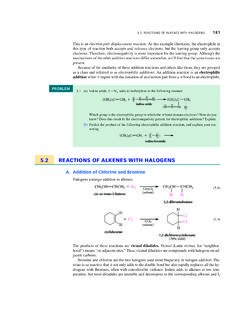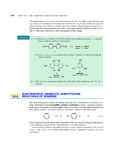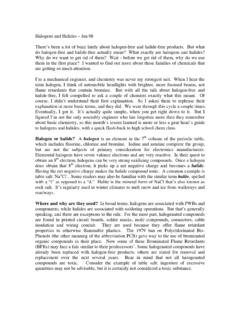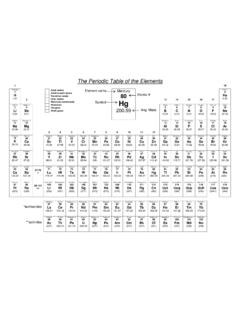Transcription of 1H chemical shifts in NMR: Part 20 Anisotropic and steric ...
1 11H chemical shifts in NMR: Part 201 Anisotropic and steric effects in halogen substituent chemical shifts (SCS), a modelling and ab-initio investigation Raymond J. Abraham1*, Mehdi Mobli1 and Richard 1 Chemistry Department, The University of Liverpool, 147, Liverpool L69 3BX, UK 2 GlaxoSmithKline, Medical Research Centre, Gunnels Wood Rd, Stevenage, Herts SG1 2NY,UK Keywords: NMR, 1H, Halogens, SCS, Anisotropy, steric , NMR Prediction, GIAO, ACD *E-mail: Tel: +44 151 794 3511 Abstract The 1H NMR spectra of the 1-halonapthalenes were recorded and assigned. This data together with the known 1H chemical shifts of the halobenzenes and of H-5 in 4-halophenanthrenes was used to investigate different models of halogen SCS using the CHARGE programme.
2 Good agreement was obtained with the observed shifts for the fluoro compounds, but a new model which included the anisotropy of the C-X bond (X = Cl, Br, I) as well as steric and electric field effects was required to give an accurate description of the observed chemical shifts for the other halogens. A previous observation of an anomalous 1H SCS on the meta protons in halobenzenes was further investigated using the 1-halonapthalenes plus the observed 1H shifts of a number of 2-substituted bromobenzenes. The meta SCS of the bromo substituent in the bromobenzenes was only observed on H-5. When a substituent was attached to C-2 , H-3 showed no appreciable effect. This remarkable effect was investigated by CHARGE and GIAO calculations and shown to be due to the electron system.
3 It was reproduced in CHARGE as a effect from the C-X carbon atom. 2 The observed 1H chemical shifts in the above compounds were compared with those calculated by CHARGE, the ab-initio GIAO technique and by the ACD data base programme. The recommended basis set for the iodo compounds (Lan12DZ ) gave very poor calculated shifts and this suggests that 1H chemical shifts of 4th row atoms when calculated with the GIAO technique should be viewed with caution. In contrast the recommended 6-31G** basis set with the B3 LYP technique in the Gaussian98 programme gave calculated values in reasonable agreement with the observed data as did the ACD package.
4 These different prediction methods were compared by Pie charts, scatter plots and rms errors and the CHARGE programme is shown to be more accurate for the compounds considered here than the other two methods. The different philosophy s of these programmes are discussed together with the results obtained. 3 Introduction Halogen 1H SCS have been calculated and discussed for many years,2-6 yet there is still no agreement as to the detailed mechanism of these shifts . Zurcher2 in a pioneering study used the electric field of the C-X bond dipole to explain the chlorine SCS in chlorosteroids. Adding an anisotropy term improved his data only slightly. The C-Cl anisotropy was small (0-5 x 10-30 cm3/molecule) and positive.
5 Homer et. in contrast used only the magnetic anisotropy of the C-F and C-Cl bonds to calculate the 1H chemical shifts in a range of haloalkanes. Later Davis et al4 analysed chloro and bromo SCS in halosteroids and obtained poor results when only the electric field was used. When a magnetic anisotropy term was introduced their calculations compared well with the experimental. The best agreement was obtained when the magnetic dipole was placed at the halogen atom. More recently Schneider et. investigated a number of haloandrostanes. They used only the C-X electric-field in their calculations and obtained satisfactory results. Including the magnetic anisotropy made the results worse.
6 Subsequently they extended their data to include halo derivatives of trans decalin. The data still fitted well with the experimental but the correlation worsened going from chlorine to bromine and iodine. Later Abraham et al7, 8 found that both the C-X electric field and a steric contribution were needed to calculate halogen SCS s for a range of Cl, Br and I alkanes. However fluorine SCS were explained using only the C-F electric field. They obtained good agreement with the observed shifts for a range of haloalkanes. All the above models of halogen SCS considered only aliphatic systems. There is little data on the calculation of proton SCS s in haloaromatics.
7 Urmani9 in a study of 2-phenylthiazolidines, correlated the SCS of several different substituents to the Hammett coefficients and the Swain-Lupton reactivity models. Including the halogens gave much poorer correlation coefficients. Note that these parameters are derived from pH and rate 4constants and therefore reflect energy differences between the anion or the transition state and the ground state of the molecule, which are not directly related to the 1H chemical shifts . Abraham et al6 calculated 1H shifts in halobenzenes by including ring current and effects. They obtained good results for the ortho and para protons of the halobenzenes, but observed anomalous effects on the meta protons which were particularly noticeable for the larger halogens.
8 Similar effects were observed for the 3,5eq protons of 1eq-chlorocyclohexane7, 8 and it was suggested that these shifts may be due to a through bond W effect. We shall show that this meta effect is due to the aromatic ring and can be incorporated into the CHARGE model. Also in an investigation of hydrogen bonding in phenols10 it was noted that the halogen steric term given previously7, 8 was always much too large for the OH proton of 2-halophenols. It is therefore necessary to determine the steric term for aromatic halogen compounds. Aromatic compounds with a proton in spatial proximity to the halogen substituent and more than three bonds removed are the 1-halonapthalenes and 4-halophenanthrenes.
9 The chemical shifts of H-5 in 4-halophenanthrenes have been given11. Here we present the assignments of the 1H spectra of all the 1-halonapthalenes and show that the calculation of these 1H chemical shifts can be well reproduced by the CHARGE method. An alternative method of calculating NMR chemical shifts is by the ab initio gauge-invariant atomic orbital (GIAO) method in which the nuclear shielding tensor is calculated. This method has been used successfully in the calculation of heavy atom chemical shifts12. Pualy et. in a discussion of the GIAO method note that since the chemical shift range of 1H is the smallest of all atoms it will be very sensitive to variation in the methodology such as the geometry, basis set etc.
10 Also since the protons are located on the periphery of the molecule their chemical shifts will be more sensitive to intermolecular interactions (solvent effects etc.) which have so far not been included in these calculations. However recently this method has been used to calculate 1H chemical shifts in organic compounds. Lampert et al13 5calculated the 1H shifts of a range of aromatic aldehydes and phenols and Colombo et al14 used these calculations to determine the configuration of the 3-hydroxy metabolites of a synthetic steroid tibolone. The major problem with these calculations is the basis set dependence. Colombo et al14 used a variety of basis sets and methodology (6-31G* and 6-31G** with HF, B3 LYP, B3PW91) in their calculations.








